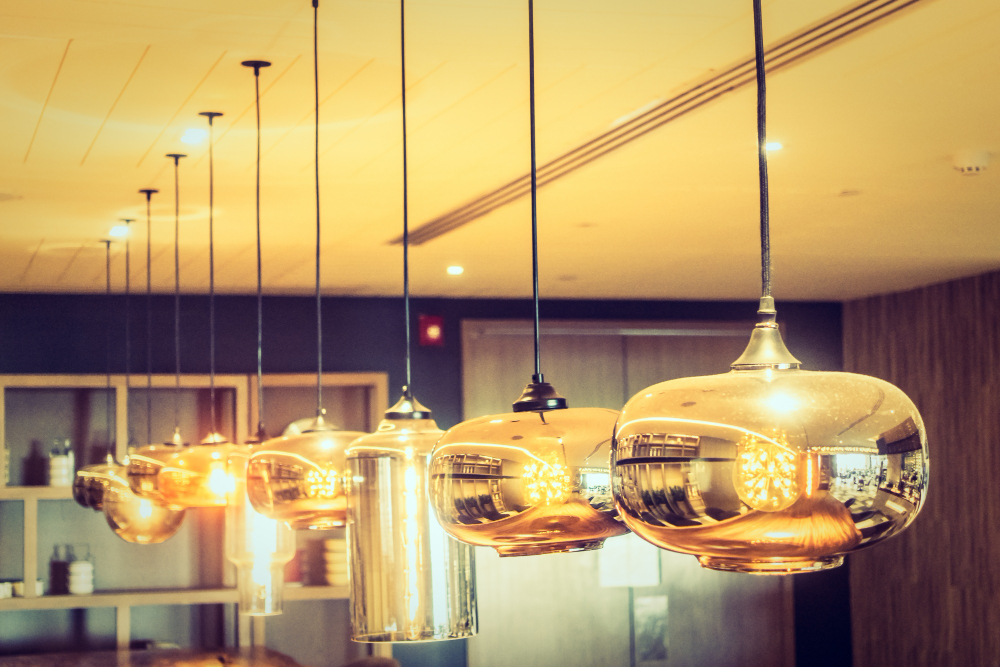Strategic lighting design can enhance the ambiance, highlight key products, and even drive sales. Don’t underestimate its impact—proper lighting can transform your store and improve the overall shopping experience. Here are some key factors to consider as you create the ideal retail environment.

The Importance of Lighting in Retail Store Design
Lighting is a cornerstone of retail store design, shaping the customer experience, influencing purchasing behavior, and enhancing brand identity. Effective lighting creates an inviting atmosphere, highlights products, and guides shoppers through the store, ultimately driving sales. For businesses seeking turnkey interior solutions for retail, understanding the role of lighting is critical to creating a space that captivates and converts. In this blog, we explore why lighting matters, its impact on retail environments, and practical tips for optimizing it, with insights tailored for businesses looking for the best retail interior designers in Delhi, fashion retail interior design specialists, and more.
Why Lighting Matters in Retail Store Design
Lighting is more than just illumination—it’s a strategic tool that sets the mood, directs attention, and communicates your brand’s personality. Whether you’re a boutique owner, a chain retailer, or planning a modular exhibition stall design in India, the right lighting can make or break your store’s success. Here’s why:
1. Creates a Welcoming Atmosphere
The first impression of a retail store begins with its ambiance. Lighting sets the tone, making customers feel comfortable and engaged. Warm lighting creates a cozy, inviting vibe, ideal for boutique stores, while bright, cool lighting energizes spaces like supermarkets or tech stores. For kiosk design companies in Delhi NCR, compact yet impactful lighting solutions can transform small spaces into eye-catching displays.
2. Enhances Product Visibility
Proper lighting highlights products, drawing attention to key merchandise. For instance, fashion retail interior design specialists use accent lighting to showcase clothing textures, colors, and details, making them more appealing. Spotlights, track lights, or LED strips can emphasize premium products, while ambient lighting ensures the entire store is well-lit and navigable.
3. Influences Customer Behavior
Lighting subtly guides customer behavior. Brightly lit areas attract shoppers, while softer lighting encourages lingering in cozy corners. Visual merchandising consultants in Delhi often use lighting to create focal points, such as highlighting a new collection or a sale display. Strategic lighting can also direct foot traffic, ensuring customers explore the entire store.
4. Reinforces Brand Identity
Your lighting choices reflect your brand. Luxury stores use elegant chandeliers or soft, diffused lighting to convey sophistication, while modern retailers opt for sleek, minimalist fixtures. For businesses working with a retail interior fit-out company in Faridabad, aligning lighting with brand aesthetics ensures a cohesive and memorable shopping experience.
5. Boosts Energy Efficiency
With rising energy costs, efficient lighting solutions like LEDs are a game-changer. They offer long-term savings, reduce heat output, and allow for customizable color temperatures. For retail chains looking for advantages of turnkey interiors for retail chains, energy-efficient lighting reduces operational costs while maintaining a premium look.
Types of Retail Lighting and Their Applications
To create a balanced and effective lighting plan, retailers must combine different types of lighting. Here’s a breakdown of the key types and their roles:
1. Ambient Lighting
Purpose: Provides overall illumination for the store.
Application: Ensures customers can navigate the space comfortably. Ceiling lights, recessed lights, or large fixtures are common choices.
Example: A clothing store might use soft ambient lighting to create a warm, welcoming environment.
2. Accent Lighting
Purpose: Highlights specific products or displays.
Application: Spotlights or track lights can focus on mannequins, shelves, or promotional areas. This is especially crucial for fashion retail interior design specialists to emphasize seasonal collections.
Example: A jewelry store uses pinpoint lighting to make diamonds sparkle.
3. Task Lighting
Purpose: Illuminates functional areas like cash counters or fitting rooms.
Application: Bright, focused lighting ensures staff can work efficiently and customers feel confident in their purchase decisions.
Example: A kiosk design company in Delhi NCR might use task lighting to illuminate payment areas in a compact setup.
4. Decorative Lighting
Purpose: Adds aesthetic appeal and reinforces brand identity.
Application: Chandeliers, pendant lights, or custom fixtures create a unique vibe, perfect for luxury or boutique stores.
Example: A high-end retail chain might use statement lighting to elevate its turnkey interior solutions for retail.
Step-by-Step Guide to Setting Up Lighting for a Retail Store in India
For businesses embarking on a retail setup, lighting is a critical component. Here’s a step-by-step guide to setting up a retail store in India with a focus on lighting, ideal for those collaborating with the best interior contractor for malls in Delhi NCR or visual merchandising consultants in Delhi:
Step 1: Assess Your Store’s Needs
Evaluate your store’s size, layout, and product type. A large department store requires uniform ambient lighting, while a modular exhibition stall design in India might prioritize compact, high-impact accent lights. Consider your brand’s vibe—luxury, casual, or trendy—and align lighting accordingly.
Step 2: Work with Experts
Partner with best retail interior designers in Delhi or a retail interior fit-out company in Faridabad to create a tailored lighting plan. Professionals can balance aesthetics, functionality, and energy efficiency, ensuring your store stands out.
Step 3: Choose the Right Fixtures
Select fixtures that suit your store’s design. LEDs are versatile, offering dimmable options and vibrant colors. For fashion retail interior design specialists, consider adjustable track lights to highlight changing displays.
Step 4: Layer Your Lighting
Combine ambient, accent, task, and decorative lighting for a dynamic effect. For example, a kiosk design company in Delhi NCR might use ambient lighting for overall visibility, accent lighting for products, and decorative lighting to attract attention.
Step 5: Test and Adjust
Once installed, test your lighting at different times of the day. Adjust brightness, angles, and color temperatures to optimize the customer experience. Visual merchandising consultants in Delhi can help fine-tune displays to maximize impact.
Step 6: Prioritize Maintenance
Regularly clean fixtures and replace bulbs to maintain consistent lighting. For turnkey interior solutions for retail, maintenance plans ensure long-term performance without disruptions.
Advantages of Thoughtful Lighting in Retail Chains
For retail chains, lighting consistency across multiple locations is key. Herewater: Advantages of turnkey interiors for retail chains include:
Brand Consistency: Uniform lighting designs reinforce brand identity across all stores.
Cost Savings: Energy-efficient lighting reduces operational costs for multiple locations.
Scalability: Modular lighting systems are easy to replicate, making them ideal for chains working with best interior contractors for malls in Delhi NCR.
Enhanced Customer Experience: Consistent, high-quality lighting creates a seamless shopping experience, encouraging repeat visits.
Lighting Mistakes to Avoid
Overly Bright Lighting: Harsh lighting can make customers feel uncomfortable. Balance brightness with warmth.
Ignoring Natural Light: Leverage windows or skylights to reduce energy costs and create a vibrant atmosphere.
Inconsistent Lighting: Uneven lighting creates dark spots, making parts of the store less inviting.
Neglecting Maintenance: Dusty or flickering lights detract from the shopping experience.
Partnering with Experts for Retail Lighting Success
Lighting is a complex aspect of retail design that requires expertise. Collaborating with best retail interior designers in Delhi, fashion retail interior design specialists, or a retail interior fit-out company in Faridabad ensures a professional approach. These experts can:
Design custom lighting plans tailored to your brand.
Source energy-efficient, high-quality fixtures.
Integrate lighting with modular exhibition stall design in India or kiosk design company in Delhi NCR projects for cohesive aesthetics.
Provide turnkey interior solutions for retail that include installation and maintenance.
Lighting is a powerful tool in retail store design, shaping customer perceptions, boosting sales, and reinforcing brand identity. By understanding its importance and working with professionals like visual merchandising consultants in Delhi or best interior contractors for malls in Delhi NCR, retailers can create spaces that are both functional and unforgettable. Whether you’re setting up a single boutique or a chain of stores, thoughtful lighting design is an investment that pays off in customer satisfaction and profitability.
For expert guidance on creating a stunning retail space with perfect lighting, visit Asmaven to explore turnkey interior solutions for retail and connect with top-tier design professionals today.
